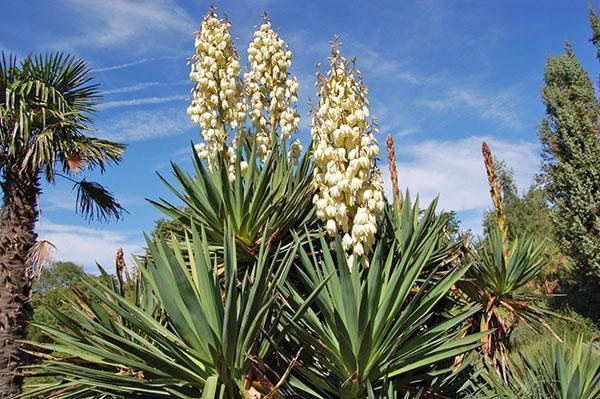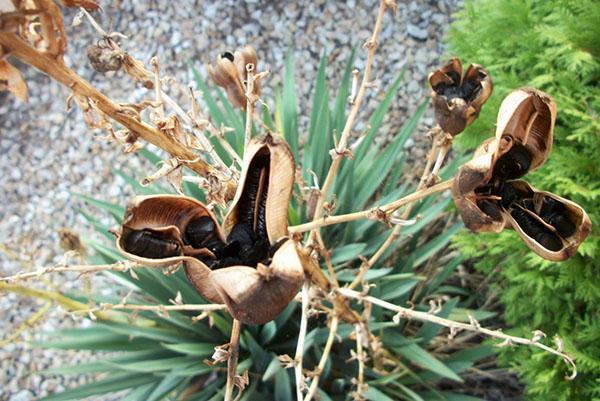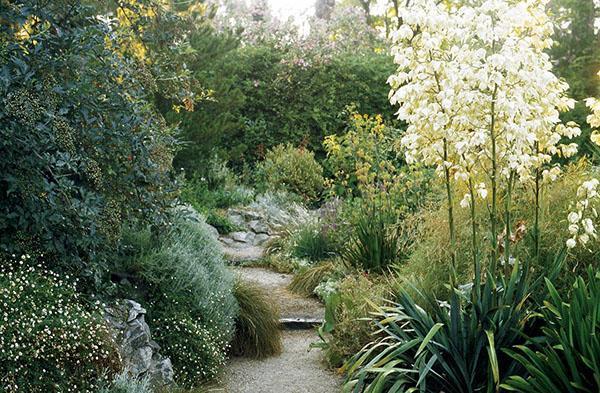We grow garden yucca in the country, planting and caring for which are simple
 The experience of growing yucca in Russia has more than a hundred years. But if at the end of the 19th century plants adorned the park ensembles of palaces, today planting and caring for yucca, in the photo, is carried out even on personal plots and in city squares.
The experience of growing yucca in Russia has more than a hundred years. But if at the end of the 19th century plants adorned the park ensembles of palaces, today planting and caring for yucca, in the photo, is carried out even on personal plots and in city squares.
The plant, which naturally occurs in the subtropical and tropical zone of the American continent, with all its exotic appearance, turned out to be not so capricious. The yucca semi-deserts, accustomed to the arid climate with sharp temperature drops, were able to acclimatize even in the middle zone. True, transferring only slight frosts in the open field, the plants need good shelter for the winter. And in the southern regions of the country, they are often grown without any restrictions. For planting and caring for yucca outdoors, two types are suitable. It is a filamentous yucca, so named for the long filaments hanging from the edges of the tough foliage, and the yucca is glorious. The first type prevails in Russian plantings, since it is more winter hardiness.

Read also the article:host - planting and care in the open field!
How to plant a yucca?

Yucca is unpretentious and hardy. She is not afraid of drought, heat and wind, but the main enemy of the plant is waterlogging and heavy soils, where there is a risk of moisture stagnation.
To simplify the care of the garden yucca, in the photo, planting is carried out in a well-ventilated, sunny place. When choosing a site for an exotic beauty, you should avoid the lowlands and corners of the garden with dense shade. The long stay of partial shade leaves a mark on the external appearance of the culture. The leaves lose their previous density, the trunk is pulled out. As a result, the plant looks pretty messy even when given full care.
Yucca has no special requirements for the composition of the soil. The main thing is that the roots receive enough air, and the water does not linger in the soil. Therefore, before planting yucca, sand is added to the substrate for filling the pit in areas with dense black soil or clay. A drainage layer is needed at the bottom, and humus is added to the substrate to provide nutrition, especially on poor soils.
Despite the unpretentiousness of the culture, it will not work at all without leaving after planting yucca in the open field.
How to care for a garden yucca flower?
After planting, the plants need very moderate watering, sanitization, which consists in removing dead foliage and wilted peduncles, rare dressing and pruning.
Watering is carried out at the root, trying not to flood the core of the outlet, since the water remaining here for a long time is the main reason for crown decay and the need for cardinal pruning of the yucca.
 As a rule, garden yucca is rarely affected by pests or diseases, and with a good shelter it winters well even in the Moscow region.So that the roots of the plant breathe more actively, and the moisture remaining under the dense rosette does not become the cause of rotting of the lower leaves and roots, the space under the garden yucca is regularly loosened, along the way removing weeds and fallen leaf plates.
As a rule, garden yucca is rarely affected by pests or diseases, and with a good shelter it winters well even in the Moscow region.So that the roots of the plant breathe more actively, and the moisture remaining under the dense rosette does not become the cause of rotting of the lower leaves and roots, the space under the garden yucca is regularly loosened, along the way removing weeds and fallen leaf plates.
If the place for the culture was initially chosen incorrectly, the plant up to three years of age can be transferred to another, more suitable site.
How to transplant a yucca? Although the plant belongs to evergreen crops, for the winter its biological processes freeze, and the new growing season begins only in spring. This time is used to transplant garden yucca, caring for which in such a situation is sometimes complicated by painful addiction to a new place of residence. When transferring a bush, it is important to try to preserve the entire root system of the plant, preventing it from drying out. To do this, when transplanting, use any means for moderate moisturizing of the roots of dug plants.
 The transplanted specimens are not fed for about a month, and the rest of the yucca in the garden must be fertilized in the spring and then in the summer, before flowering and after the inflorescences wither.
The transplanted specimens are not fed for about a month, and the rest of the yucca in the garden must be fertilized in the spring and then in the summer, before flowering and after the inflorescences wither.
 At 3-4 years old, yucca bloom for the first time, and the racemose inflorescence retains its decorative effect for about a month. To maintain the strength of the plant will help feeding with complex compositions with a predominance nitrogen... Fertilization is stopped a month before the onset of autumn coolness. This will allow the yucca to prepare for the winter and survive the cold.
At 3-4 years old, yucca bloom for the first time, and the racemose inflorescence retains its decorative effect for about a month. To maintain the strength of the plant will help feeding with complex compositions with a predominance nitrogen... Fertilization is stopped a month before the onset of autumn coolness. This will allow the yucca to prepare for the winter and survive the cold.
Shelter for a garden yucca for the winter
Plants tolerate sudden snow falling in autumn or spring without loss, the main thing is that it melts within a couple of days. But stable cold weather and snowless winters are deadly for garden yucca.
First of all, the growth point in the core of the outlet suffers from frost, and then the vegetative root system. A frame shelter, representing a spacious box as high as an adult plant, helps to protect the culture.
Before covering the foliage, the yucca is collected up and tightly wrapped with a strong cord. Then the plant is covered with a box on top and abundantly sprinkled with spruce branches or fallen leaves. The entire structure is wrapped with a covering material and secured with tape. Checking the stability of the structure. In this form, the plant will spend the winter without problems, it will be especially comfortable under a layer of snow.
 You can remove the frame and remove the foliage with the arrival of stable positive temperatures. If you are late with the "release of the captive" there is a danger of mold and decay due to the activation of respiration and the beginning of the growing season of the plant inside the enclosed space.
You can remove the frame and remove the foliage with the arrival of stable positive temperatures. If you are late with the "release of the captive" there is a danger of mold and decay due to the activation of respiration and the beginning of the growing season of the plant inside the enclosed space.
How to propagate yucca?
 Although with proper care after planting, the garden yucca, as in the photo, blooms, it will not work to wait for its seeds in the middle lane. How to propagate garden yucca? There are several ways to get young independent plants. Most often, daughter rosettes are used, which are formed at the base of an adult bush. It is better to take layers with already developed own root system. This will speed up acclimatization and allow plants to quickly develop in a new location.
Although with proper care after planting, the garden yucca, as in the photo, blooms, it will not work to wait for its seeds in the middle lane. How to propagate garden yucca? There are several ways to get young independent plants. Most often, daughter rosettes are used, which are formed at the base of an adult bush. It is better to take layers with already developed own root system. This will speed up acclimatization and allow plants to quickly develop in a new location.
Daughter outlets are easily detached when transplanting a garden yucca, while caring for them is no different from what other plants receive. At the same time, do not forget that the cut sites are most susceptible to all kinds of infections and pest attacks. Therefore, they are slightly dried and sprinkled with crushed coal or cinnamon powder.
During the spring transplant, several cuttings from 5 to 10 cm long can be cut from a healthy strong root. They are treated with coal and planted in a greenhouse, lightly sprinkled with a wet sand-peat mixture. In this case, the formation of shoots occurs due to dormant buds.
Another way that allows not only to rejuvenate a plant that has grown and lost its compactness, but also to propagate an exotic guest, is pruning. How to make a yucca more fluffy and get quality planting material?
How to prune a yucca?
It is best to prune the plant in spring, when it has just been freed from winter shelter.Since the yucca has only one growth point, by cutting off the stem, the gardener completely stops its vertical development. And yet the flower's life will not freeze, the buds sleeping on the stem will wake up and give several new outlets.
Pruning is a great way to rejuvenate the flower, get strong garden yucca seedlings, and save rot or frost-affected specimens.
 Before cutting the yucca, water the plant a couple of days before the operation. The cut is made with a very sharp, clean knife so that:
Before cutting the yucca, water the plant a couple of days before the operation. The cut is made with a very sharp, clean knife so that:
- in its place there were no splits in the stem, damage or peeling of the bark;
- it fell 8-10 cm below the foliage growth line.
When the places of the cuts dry out a little, they, both on the hemp and on the top, are treated with fungicide and charcoal powder.
INThe top of the hemp remaining to the ground after pruning the yucca can be covered with garden varnish, which will provide long-term reliable protection in the garden.
On an old plant, covered from the scorching sun, sprouts will appear newer in 2–3 weeks. If the yucca is strong, 3 to 5 buds are left on the hemp. Small specimens will not be able to support the growth of more than two young tips.
The old top is not thrown away, but used for planting garden yucca, the care of which is not much different from the situation when daughter sockets are transferred to the ground. True, before this, the seedling needs to be rooted. It is best to do this in a greenhouse, keeping an eye out for condensation to form and keeping an eye on the moderate moisture content of the sandy substrate.
The fourth year grows from a seed yucca filamentous in a pot. For the summer I take it out into the yard, into the sun. I'm afraid to land on a permanent place in the garden. In our area, winter has changed over the past decade and it is unlikely that it will be possible to preserve the yucca. I would venture to separate the roots in the spring for a safety net and determine the mother bush for a residence, there is a suitable place for this. I don't water it especially in winter, I feed it in December and February with Urgas (em-powder) or SLOKS for root feeding. Both are good for all types of flowers and for all vegetation.
hello. please tell me how to ennoble our yucca, it has been growing in the country for 5 years already and this year, she doesn't look very good
It looks like one of the yucca rosettes is completely missing - the one with the yellow center. Perhaps there was moisture and the outlet rotted. You definitely need to clean the bush by cutting off everything dry.
Several years ago (4-5) I bought YUKKU. Finally waited for flowering! Lovely !!!
So you can only plant in the spring? And in the summer you can not separate the shoots from the root?
I have had yucca for several years now. It bloomed every time. But it does not bloom this year. Maybe she should be seated? There are a bunch of 20 sockets for sure.
She planted a yucca in 2017 and this year she has already pleased with her flowering. Question: the flowers fell off, but the bare stem remained, can I trim it? And the view is not very .. Thanks in advance).
Cut the dry stem if you do not want to get seed pods.
Got it, thanks!
Please tell me, it has not successfully plucked the yucca process, it is now without roots, will a root appear if you put it in a vessel with water ?? Thanks for earlier))
Should appear. You can root the stalk either in water or in light soil, creating greenhouse conditions for it (that is, covering it with a transparent bag).
Do I need to remove new shoots from the yucca? And then this year the yucca gave a lot of children and did not bloom. Maybe there is a connection here?
Good day . They say that if you cut off the bottom leaves of a yucca, it will grow like a palm tree.Is it true?
The indoor yucca will most of all look like a palm tree - it itself, as it grows and ages, sheds the lower leaves. Garden yucca species grown in the open field are most often represented by plants with a short trunk, but a lush deciduous rosette.
I bought a garden yucca this year, it has not grown very much over the summer. I live in Siberia and I am afraid to leave it, so small, 20 cm, to winter in the open field. Can grow at home over the winter and even then put in a permanent place. ???
I understand that you have not planted it in open ground yet? If it is a filamentous yucca, then on the street it can withstand up to 30 ° frost, provided that it is sheltered, of course. But if in your area the winters are even more evil, then it is better to take the baby into the house for now.
Yuka sadovaya at the age of 3-4 years and older
Got a yucca seedling in November. What to do - put in a pot? I live in the South Urals, winter is tougher than in the suburbs.
I would plant it in a pot, especially since the garden yucca still seems to freeze for the winter, it stops developing. When landing in open ground, there are now two options, and both are sad. Either it will disappear, because it will not have time to take root, or it will simply freeze, small and weak for now. So it's better not to risk it, into the pot - and into the house.